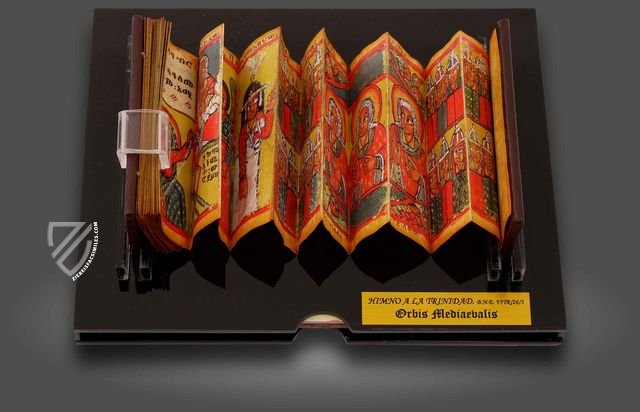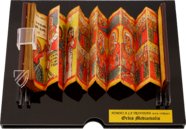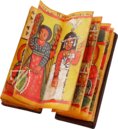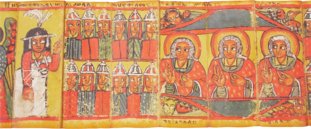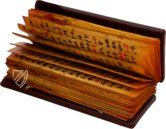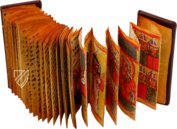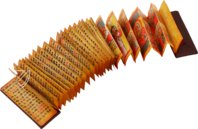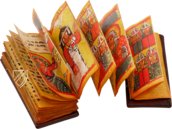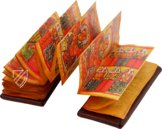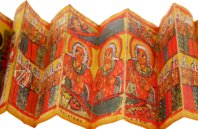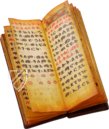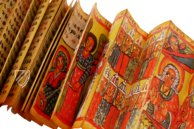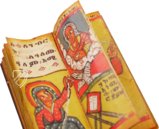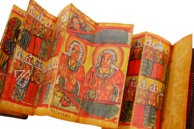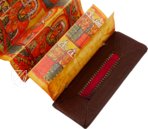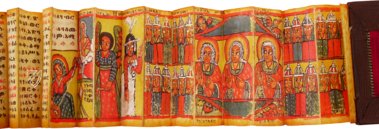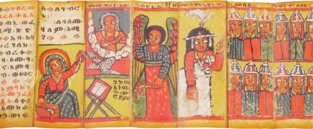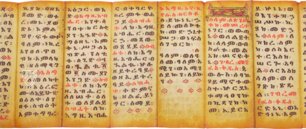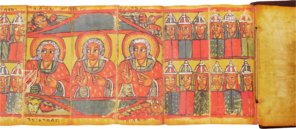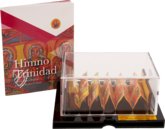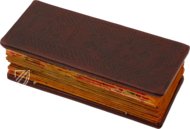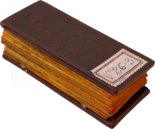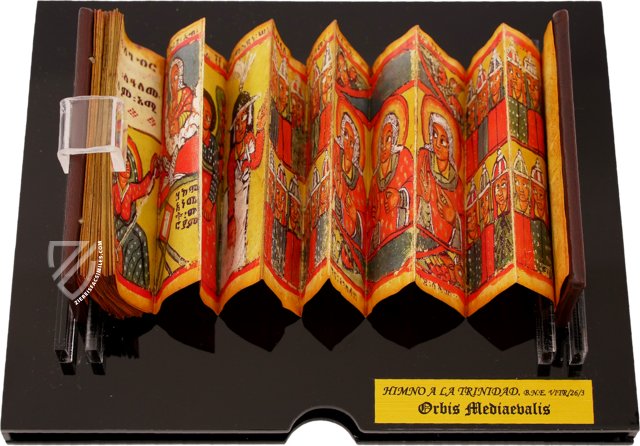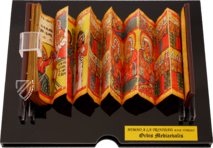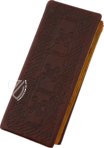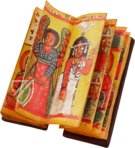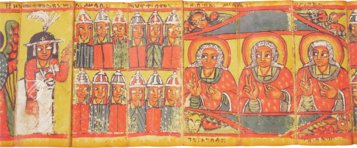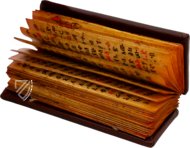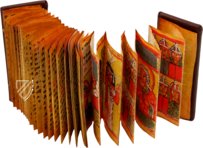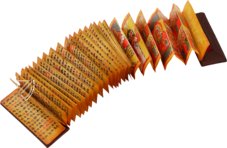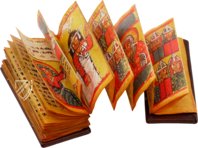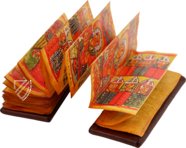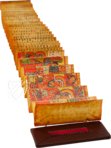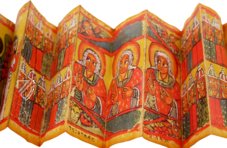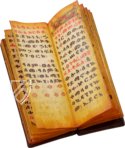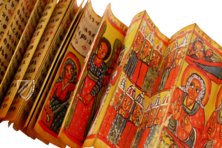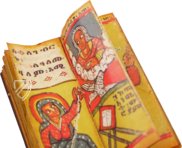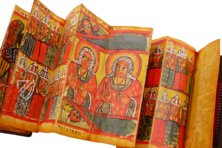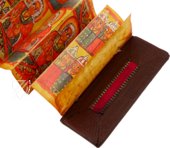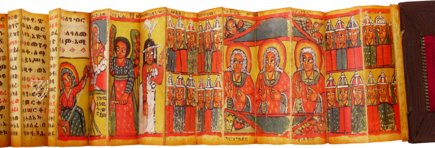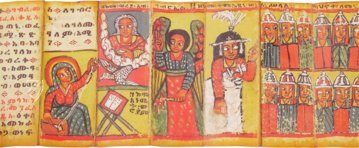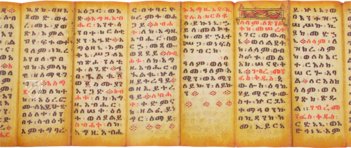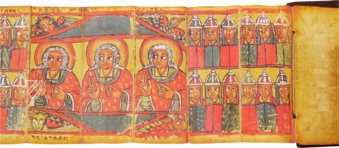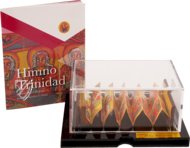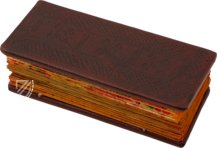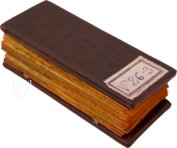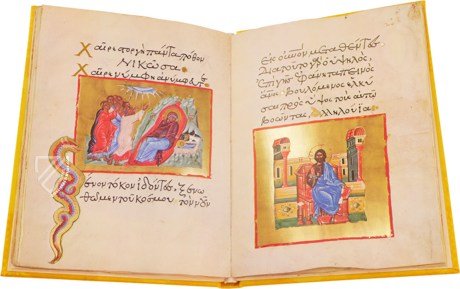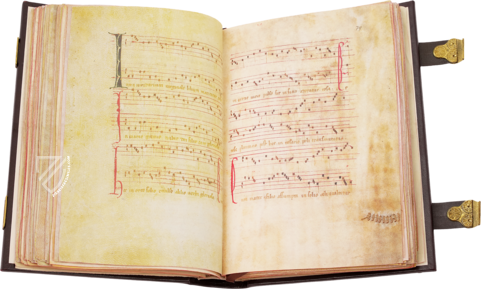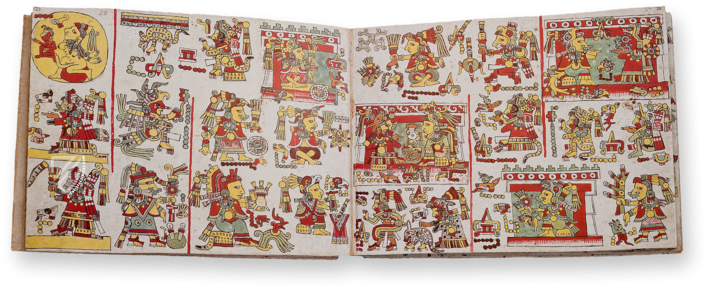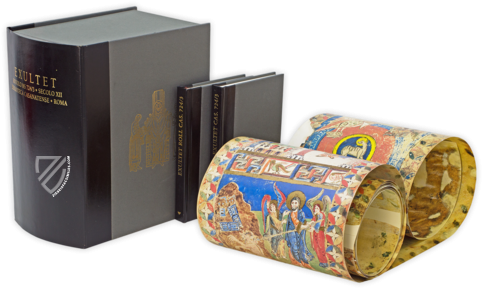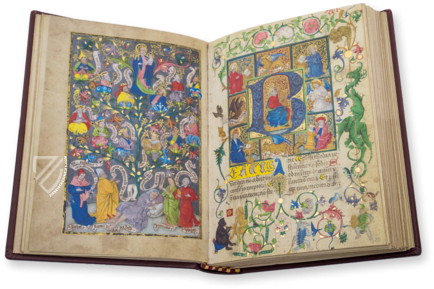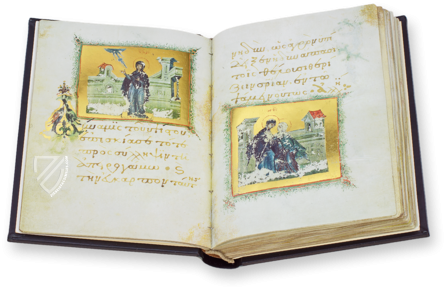Hymn to the Trinity
(1,000€ - 3,000€)
In the tradition of Ethiopian book art, a sänsul is a folded book with colorful illustrations characterized by figures with large, almond-shaped eyes appearing throughout the manuscript. Included among them is a beautifully dressed noblewoman appearing at the beginning who probably commissioned the work. This sänsul is a rare and precious example of 15th century Ethiopian “Naif” illumination containing hymns and poems of praise dedicated various aspects of the Christian faith including the Annunciation, Holy Trinity, the Elders of the Apocalypse, and Saint Gabra Manfas Qeddus, an Egyptian monk who supposedly lived for centuries before coming to Ethiopia to preach the Good News. The familiar winged Evangelist Symbols (man, lion, ox, eagle) are used to decorate the image of the Holy Trinity and the text is written in Ge’ez, a classical Ethiopian language still used for liturgical purposes today. This impressive example of Ethiopian art provides a fascinating insight into medieval Christianity outside Europe.
Hymn to the Trinity
Ethiopia is one of the oldest countries in the world and was the second to adopt Christianity and as such as a unique and fascinating tradition of religious art. The small yet richly illuminated manuscript at hand is a so-called sansül, an accordion book carried by members of the Ethiopian elite in the same manner that European nobles carried books of hours. It belongs to the Melke’ genre of the Ge’ez language, which praises the Holy Trinity, Virgin Mary, archangels, and the most venerated saints of Ethiopian Christianity.
Poems of Praise
Originating from the hand of a monk in the Gondar region, the text is written in black and red ink and appears to be a copy of a poem from the 11th century Oxyrhynchus Papyri. Arranged in stanzas of 4-6 verses, the poem equates every part of the body with passages from the Bible and graces attributed to the Trinity. Special attention in the manuscript is also paid to Saint Gabra Manfas Qeddus (also spelled Gebre Menfes Kidus), to whom the fifth day of every month in the Ethiopian calendar is dedicated. Written on both sides of the folded parchment, the text is written in 16-line columns – 51 on the recto side and 40 on the verso, which introduces the miniatures. The first depicts the Annunciation and shows the Virgin Mary sewing and reading a book when the Angel Gabriel appears above her in a ring of clouds as the Holy Spirit in the form of a dove flies toward her.
A Unique Artistic Tradition
Although many Ethiopian arts and crafts such as textiles and jewelry are fairly similar to those of their neighbors, the religious art of Christian Ethiopia is distinctive and unique among its Muslim neighbors. Nonetheless, there is some evidence of Byzantine influences in the work, such as the static, typified presentation of faces and with large eyes and expressive, exaggerated hand gestures. However, Ethiopian artists had their own innovative variations on typical devices in Christian art, such as the mandorla – an almond shaped framed in which Christ in Majesty is typically presented. This manuscript’s representation of the Holy Trinity uses a hexagonal mandorla inside of a square, creating spaces in the corners for the Four Evangelist symbols and they are in turn flanked in the margins by the Twenty-Four Elders from the Book of Revelation. Similar to a European book of hours, a richly dressed female figure appears in the margins between the scenes, most likely the patron of the work.
The Ancient Roots of Ethiopian Christianity
Around the year 316, a young Christian missionary named Frumentius and his brother Edesius were enslaved when their ship came into a port on the Red Sea and given to the king of the Ethiopians in Aksum. From their servitude they rose to positions of trust at the royal court, whose members they began to convert to Christianity. An Ethiopian coin dated 324 already shows indications that the conversion of the entire country was underway. The majority of the country was converted in the course of the 330’s and Christianity was declared the state religion ca. 340. Closely related to the Coptic Christianity of Egypt, the Ethiopian Orthodox Tewahedo Church has been the predominant religion in Ethiopia for over 1,500 years.
Ethiopia and Europe
After its neighbors were converted to Islam in the course of the 7th century, Ethiopia became isolated from other Christian nations. During the course of the Middle Ages and especially after the beginning of the Crusades, Europeans made continuous attempts to make contact with Ethiopia as a Christian ally in the region and vice versa. Ethiopian monks also travelled to the West, participating in the 1441 Council of Florence, for example. Portugal became the first European country to establish continuous relations with Ethiopia, which began in 1508, but the country remained relatively isolated and fiercely independent. Ethiopia was one of only two African nations to avoid colonization in the 19th century and the Ethiopian identity continues to be defined by Christianity and a spirit of independence.
Codicology
- Alternative Titles
- Himno a la Trinidad
Hymne an die Dreifaltigkeit - Size / Format
- 52 pages / 9.5 × 4.0 cm
- Origin
- Ethiopia
- Date
- 15th century
- Epochs
- Style
- Content
- Poem of praise to the Holy Trinity as well as prayers and a praise to the popular saint Gebre Menfes Kidus
Hymn to the Trinity
The Annunciation
The Virgin Mary is sewing and sitting in front of a book resting in a folding lectern called a rehal, which comes from the Arabic word for “camel saddle” and was adopted by Ethiopian Christians who were surrounded by Muslim neighbors. Mary is adorned by a colorful halo and her hair is completely covered by her blue cloak as the archangel Gabriel, accompanied by a white dove representing the Holy Spirit, appears in a ring of clouds with white hair and the two look directly at each other.
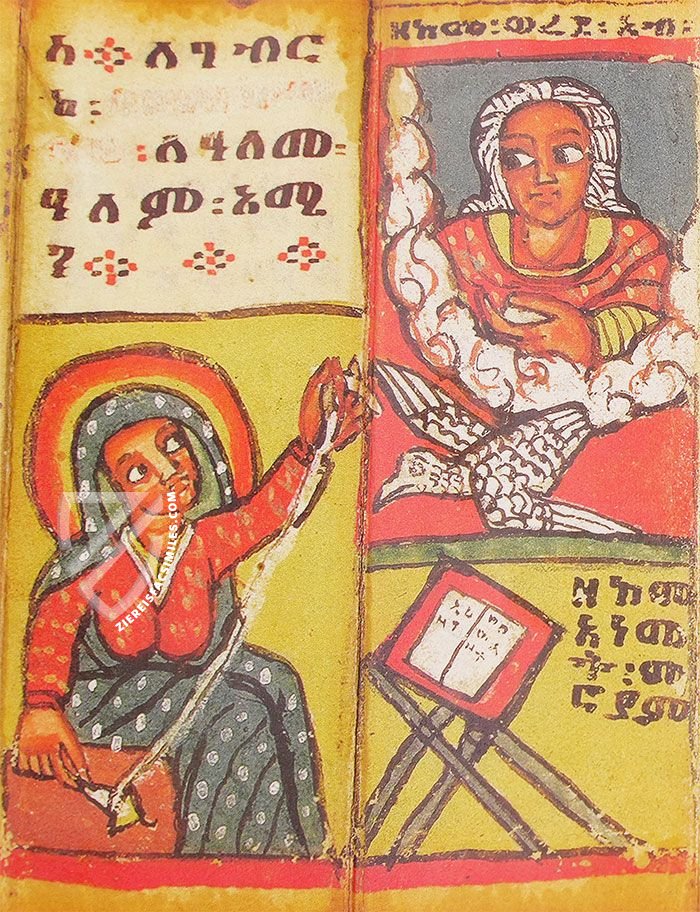
Hymn to the Trinity
The Holy Trinity
Flanked by the Twenty-Four Elders from the Book of Revelation, twelve of whom are shown here, the Holy Trinity is represented by three virtually identical male figures making the benediction gesture. They are presented in a unique hexagonal mandorla inside of a square, which creates spaces in the corners for the symbols representing the Four Evangelists.
The female figure who appears in the margin of this and other miniatures dressed in white wearing a feathered black cap with a cross is probably the patron of the manuscript. Like a European book of hours, this manuscript was simultaneously an expression of piety, wealth, and sophistication that was created for the devotional use of a layperson who had themselves inserted into the artwork.
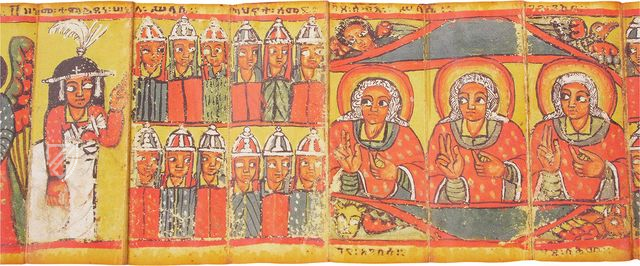
#1 Himno a la Trinidad
Language: Spanish
(1,000€ - 3,000€)
- Treatises / Secular Books
- Apocalypses / Beatus
- Astronomy / Astrology
- Bestiaries
- Bibles / Gospels
- Chronicles / History / Law
- Geography / Maps
- Saints' Lives
- Islam / Oriental
- Judaism / Hebrew
- Single Leaf Collections
- Leonardo da Vinci
- Literature / Poetry
- Liturgical Manuscripts
- Medicine / Botany / Alchemy
- Music
- Mythology / Prophecies
- Psalters
- Other Religious Books
- Games / Hunting
- Private Devotion Books
- Other Genres
- Afghanistan
- Armenia
- Austria
- Belgium
- Belize
- Bosnia and Herzegovina
- China
- Colombia
- Costa Rica
- Croatia
- Cyprus
- Czech Republic
- Denmark
- Egypt
- El Salvador
- Ethiopia
- France
- Germany
- Greece
- Guatemala
- Honduras
- Hungary
- India
- Iran
- Iraq
- Israel
- Italy
- Japan
- Jordan
- Kazakhstan
- Kyrgyzstan
- Lebanon
- Liechtenstein
- Luxembourg
- Mexico
- Morocco
- Netherlands
- Palestine
- Panama
- Peru
- Poland
- Portugal
- Romania
- Russia
- Serbia
- Spain
- Sri Lanka
- Sweden
- Switzerland
- Syria
- Tajikistan
- Turkey
- Turkmenistan
- Ukraine
- United Kingdom
- United States
- Uzbekistan
- Vatican City
- A. Oosthoek, van Holkema & Warendorf
- Aboca Museum
- Ajuntament de Valencia
- Akademie Verlag
- Akademische Druck- u. Verlagsanstalt (ADEVA)
- Aldo Ausilio Editore - Bottega d’Erasmo
- Alecto Historical Editions
- Alkuin Verlag
- Almqvist & Wiksell
- Amilcare Pizzi
- Andreas & Andreas Verlagsbuchhandlung
- Archa 90
- Archiv Verlag
- Archivi Edizioni
- Arnold Verlag
- ARS
- Ars Magna
- ArtCodex
- AyN Ediciones
- Azimuth Editions
- Badenia Verlag
- Bärenreiter-Verlag
- Belser Verlag
- Belser Verlag / WK Wertkontor
- Benziger Verlag
- Bernardinum Wydawnictwo
- BiblioGemma
- Biblioteca Apostolica Vaticana (Vaticanstadt, Vaticanstadt)
- Bibliotheca Palatina Faksimile Verlag
- Bibliotheca Rara
- Boydell & Brewer
- Bramante Edizioni
- Bredius Genootschap
- Brepols Publishers
- British Library
- C. Weckesser
- Caixa Catalunya
- Canesi
- CAPSA, Ars Scriptoria
- Caratzas Brothers, Publishers
- Carus Verlag
- Casamassima Libri
- Centrum Cartographie Verlag GmbH
- Chavane Verlag
- Christian Brandstätter Verlag
- Circulo Cientifico
- Club Bibliófilo Versol
- Club du Livre
- CM Editores
- Collegium Graphicum
- Collezione Apocrifa Da Vinci
- Comissão Nacional para as Comemorações dos Descobrimentos Portugueses
- Coron Verlag
- Corvina
- CTHS
- D. S. Brewer
- Damon
- De Agostini/UTET
- De Nederlandsche Boekhandel
- De Schutter
- Deuschle & Stemmle
- Deutscher Verlag für Kunstwissenschaft
- DIAMM
- Droz
- E. Schreiber Graphische Kunstanstalten
- Ediciones Boreal
- Ediciones Grial
- Ediclube
- Edições Inapa
- Edilan
- Editalia
- Edition Deuschle
- Edition Georg Popp
- Edition Leipzig
- Edition Libri Illustri
- Editiones Reales Sitios S. L.
- Éditions de l'Oiseau Lyre
- Editions Medicina Rara
- Editorial Casariego
- Editorial Mintzoa
- Editrice Antenore
- Editrice Velar
- Edizioni Edison
- Egeria, S.L.
- Eikon Editores
- Electa
- Emery Walker Limited
- Enciclopèdia Catalana
- Eos-Verlag
- Ephesus Publishing
- Ernst Battenberg
- Eugrammia Press
- Extraordinary Editions
- Fackelverlag
- Facsimila Art & Edition
- Facsimile Editions Ltd.
- Facsimilia Art & Edition Ebert KG
- Faksimile Verlag
- Feuermann Verlag
- Folger Shakespeare Library
- Franco Cosimo Panini Editore
- Friedrich Wittig Verlag
- Fundación Hullera Vasco-Leonesa
- G. Braziller
- Gabriele Mazzotta Editore
- Gebr. Mann Verlag
- Gesellschaft für graphische Industrie
- Getty Research Institute
- Giovanni Domenico de Rossi
- Giunti Editore
- Graffiti
- Grafica European Center of Fine Arts
- Guido Pressler
- Guillermo Blazquez
- Gustav Kiepenheuer
- H. N. Abrams
- Harrassowitz
- Harvard University Press
- Helikon
- Hendrickson Publishers
- Henning Oppermann
- Herder Verlag
- Hes & De Graaf Publishers
- Hoepli
- Holbein-Verlag
- Houghton Library
- Hugo Schmidt Verlag
- Idion Verlag
- Il Bulino, edizioni d'arte
- ILte
- Imago
- Insel Verlag
- Insel-Verlag Anton Kippenberger
- Instituto de Estudios Altoaragoneses
- Instituto Nacional de Antropología e Historia
- Introligatornia Budnik Jerzy
- Istituto dell'Enciclopedia Italiana - Treccani
- Istituto Ellenico di Studi Bizantini e Postbizantini
- Istituto Geografico De Agostini
- Istituto Poligrafico e Zecca dello Stato
- Italarte Art Establishments
- Jan Thorbecke Verlag
- Johnson Reprint Corporation
- Josef Stocker
- Josef Stocker-Schmid
- Jugoslavija
- Karl W. Hiersemann
- Kasper Straube
- Kaydeda Ediciones
- Kindler Verlag / Coron Verlag
- Kodansha International Ltd.
- Konrad Kölbl Verlag
- Kurt Wolff Verlag
- La Liberia dello Stato
- La Linea Editrice
- La Meta Editore
- Lambert Schneider
- Landeskreditbank Baden-Württemberg
- Leo S. Olschki
- Les Incunables
- Liber Artis
- Library of Congress
- Libreria Musicale Italiana
- Lichtdruck
- Lito Immagine Editore
- Lumen Artis
- Lund Humphries
- M. Moleiro Editor
- Maison des Sciences de l'homme et de la société de Poitiers
- Manuscriptum
- Martinus Nijhoff
- Maruzen-Yushodo Co. Ltd.
- MASA
- Massada Publishers
- McGraw-Hill
- Metropolitan Museum of Art
- Militos
- Millennium Liber
- Müller & Schindler
- Nahar - Stavit
- Nahar and Steimatzky
- National Library of Wales
- Neri Pozza
- Nova Charta
- Oceanum Verlag
- Odeon
- Orbis Mediaevalis
- Orbis Pictus
- Österreichische Staatsdruckerei
- Oxford University Press
- Pageant Books
- Parzellers Buchverlag
- Patrimonio Ediciones
- Pattloch Verlag
- PIAF
- Pieper Verlag
- Plon-Nourrit et cie
- Poligrafiche Bolis
- Presses Universitaires de Strasbourg
- Prestel Verlag
- Princeton University Press
- Prisma Verlag
- Priuli & Verlucca, editori
- Pro Sport Verlag
- Propyläen Verlag
- Pytheas Books
- Quaternio Verlag Luzern
- Reales Sitios
- Recht-Verlag
- Reichert Verlag
- Reichsdruckerei
- Reprint Verlag
- Riehn & Reusch
- Roberto Vattori Editore
- Rosenkilde and Bagger
- Roxburghe Club
- Salerno Editrice
- Saltellus Press
- Sandoz
- Sarajevo Svjetlost
- Schöck ArtPrint Kft.
- Schulsinger Brothers
- Scolar Press
- Scrinium
- Scripta Maneant
- Scriptorium
- Shazar
- Siloé, arte y bibliofilia
- SISMEL - Edizioni del Galluzzo
- Sociedad Mexicana de Antropología
- Société des Bibliophiles & Iconophiles de Belgique
- Soncin Publishing
- Sorli Ediciones
- Stainer and Bell
- Studer
- Styria Verlag
- Sumptibus Pragopress
- Szegedi Tudomànyegyetem
- Taberna Libraria
- Tarshish Books
- Taschen
- Tempus Libri
- Testimonio Compañía Editorial
- Thames and Hudson
- The Clear Vue Publishing Partnership Limited
- The Facsimile Codex
- The Folio Society
- The Marquess of Normanby
- The Richard III and Yorkist History Trust
- Tip.Le.Co
- TouchArt
- TREC Publishing House
- TRI Publishing Co.
- Trident Editore
- Tuliba Collection
- Typis Regiae Officinae Polygraphicae
- Union Verlag Berlin
- Universidad de Granada
- University of California Press
- University of Chicago Press
- Urs Graf
- Vallecchi
- Van Wijnen
- VCH, Acta Humaniora
- VDI Verlag
- VEB Deutscher Verlag für Musik
- Verlag Anton Pustet / Andreas Verlag
- Verlag Bibliophile Drucke Josef Stocker
- Verlag der Münchner Drucke
- Verlag für Regionalgeschichte
- Verlag Styria
- Vicent Garcia Editores
- W. Turnowski Ltd.
- W. Turnowsky
- Waanders Printers
- Wiener Mechitharisten-Congregation (Wien, Österreich)
- Wissenschaftliche Buchgesellschaft
- Wissenschaftliche Verlagsgesellschaft
- Wydawnictwo Dolnoslaskie
- Xuntanza Editorial
- Zakład Narodowy
- Zollikofer AG

